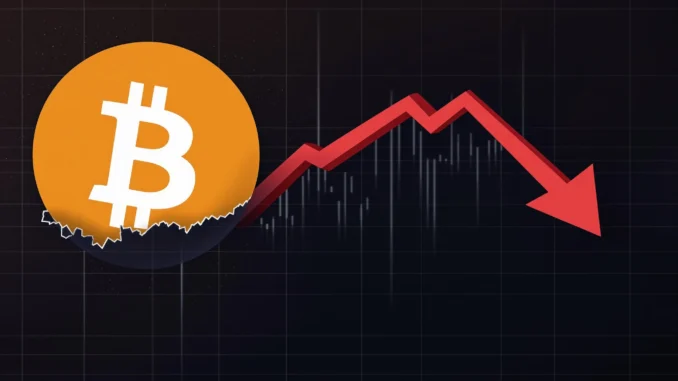
Is the Bitcoin bull run taking a breather, or is something more ominous brewing beneath the surface? For over 81 days, Bitcoin has been locked in a tight trading range between $91,000 and $102,000, leaving investors and analysts scratching their heads. While geopolitical tensions simmer globally, the crypto market’s king, Bitcoin, seems strangely unfazed, at least in terms of breaking out of its current slumber. Let’s dive deep into the latest market analysis and understand what’s causing this prolonged Bitcoin consolidation and the potential implications of a newly flagged bearish signal.
Decoding Bitcoin Consolidation: What Does It Mean?
Bitcoin consolidation essentially means a period where the price of Bitcoin trades within a relatively narrow range, without showing a clear upward or downward trend. Think of it as a pause after a significant price movement, a moment for the market to catch its breath and decide on its next direction. In Bitcoin’s case, this consolidation phase has been ongoing for nearly three months. But why is this happening, and what can we infer from it?
- Market Indecision: A prolonged consolidation often indicates uncertainty in the market. Buyers and sellers are in a standoff, with neither side able to exert enough pressure to trigger a significant price swing.
- Accumulation or Distribution?: During consolidation, whales and institutional investors might be quietly accumulating more Bitcoin at lower prices or distributing their holdings without causing a market crash. It’s a period of strategic maneuvering behind the scenes.
- Reduced Volatility: While some traders thrive on volatility, consolidation periods lead to reduced price swings. This can be both a blessing and a curse – less opportunity for quick profits, but also less risk of sudden losses.
- Potential Breakout: Historically, consolidation phases are often followed by significant breakouts, either upwards or downwards. The longer the consolidation, the more powerful the potential breakout can be.
Bitfinex Flags a Bearish Signal: Is a Downtrend Imminent?
Now, here’s where things get interesting. A recent report from Bitfinex, a prominent cryptocurrency exchange, has flagged a bearish signal using their Inter-Exchange Flow Pulse (IFP) indicator. This indicator, which tracks the flow of Bitcoin between exchanges, has turned bearish for the first time since June 2024. What exactly does this mean for Bitcoin’s price trajectory?
The Inter-Exchange Flow Pulse (IFP) indicator turning bearish suggests that:
- Increased Outflows from Exchanges: A bearish IFP typically indicates a net outflow of Bitcoin from exchanges. This can be interpreted as investors moving their BTC to cold storage or private wallets, signaling a lack of immediate intention to sell. However, in this context, Bitfinex suggests it might be a precursor to selling pressure.
- Potential Sell-Off: While moving Bitcoin off exchanges is often seen as bullish (long-term holding), a bearish signal in IFP, as interpreted by Bitfinex, hints at potential profit-taking or de-risking by investors who might anticipate a price correction.
- Market Sentiment Shift: The bearish signal could reflect a broader shift in market sentiment. After a period of altcoin focus, investors may be rotating back to Bitcoin, but with a more cautious and potentially negative outlook in the short term.
However, it’s crucial to note that analysts are urging caution. While the bearish signal from the IFP is noteworthy, it’s not necessarily a definitive predictor of a price crash. Market indicators should always be considered within a broader context, and no single signal guarantees future price movements.
Crypto Market Dynamics: Altcoins to Bitcoin Rotation
Interestingly, the current market scenario shows a shift in investor focus from altcoins back to Bitcoin. For a while, the altcoin market was buzzing with activity, with many projects experiencing significant gains. However, this trend appears to be waning, and investors are seemingly seeking the relative safety and stability of Bitcoin during this period of uncertainty and consolidation.
This rotation from altcoins to Bitcoin can be attributed to several factors:
- Risk-Off Sentiment: In times of market uncertainty or perceived risk, investors often flock to Bitcoin as a safe haven asset within the crypto space. Altcoins, being generally more volatile, tend to underperform during such periods.
- Profit Taking in Altcoins: After the recent altcoin rally, investors might be taking profits and reallocating those funds into Bitcoin, perceiving it as a less risky bet in the current climate.
- Bitcoin’s Dominance Narrative: The narrative of Bitcoin as the dominant and most established cryptocurrency tends to strengthen during market consolidation or downturns. Investors seek the security and liquidity that Bitcoin offers.
Navigating the Bitcoin Consolidation: Actionable Insights
So, what should crypto enthusiasts and investors do amidst this Bitcoin consolidation and the flagged bearish signal? Here are some actionable insights:
- Stay Informed: Keep a close eye on market indicators, news, and expert analysis. Tools like the IFP are valuable, but it’s essential to consider multiple sources and perspectives.
- Manage Risk: Consolidation periods can be unpredictable. Review your portfolio risk and consider adjusting your positions if you feel uncomfortable with the current market uncertainty.
- Zoom Out: Don’t get fixated on short-term price fluctuations. Remember Bitcoin’s long-term trajectory and the broader adoption trends in the cryptocurrency space.
- Prepare for Volatility: Whether the breakout from consolidation is upwards or downwards, expect increased volatility. Have a trading plan in place to react to potential price swings.
- Diversify (Strategically): While Bitcoin is currently in focus, strategic diversification across different asset classes, including select altcoins, can still be a prudent approach for long-term growth, but proceed with caution and due diligence.
Conclusion: The Waiting Game in Bitcoin’s Journey
Bitcoin consolidation is a natural phase in the market cycle. While the bearish signal flagged by Bitfinex adds a layer of caution, it’s crucial to remember that market signals are not guarantees. The crypto market remains dynamic and influenced by numerous factors. For now, the Bitcoin market seems to be in a waiting game, gathering momentum for its next significant move. Whether that move will be upwards or downwards remains to be seen. Smart investors will use this period to strategize, stay informed, and prepare for the next chapter in Bitcoin’s fascinating journey.



